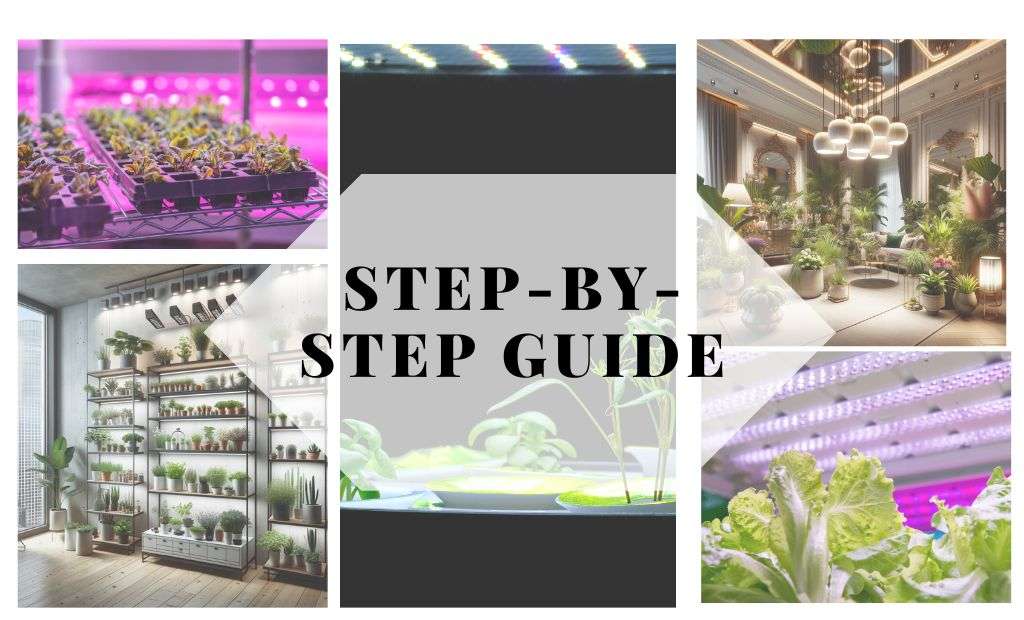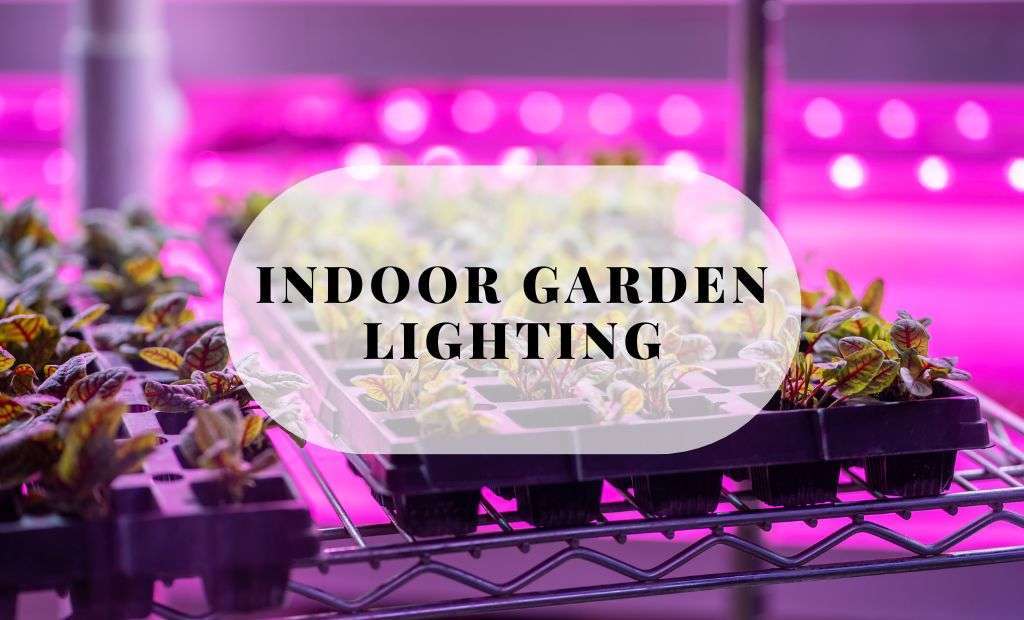If you are looking for a Step-by-Step Guide to Indoor Garden Lighting, then you have come to the perfect place. Indoor gardening offers a slice of nature within our homes and workplaces, creating a tranquil and green environment. However, one of the most vital elements for nurturing indoor plants is light. This blog will illuminate the essentials of indoor garden lighting, guiding you through different types of lights, considerations for setup, and tips for maintaining a vibrant indoor garden.
Understanding Plant Light Needs
Plants require light primarily for photosynthesis, the process by which they convert light into energy. However, not all plants have the same light requirements. Generally, they are categorized into three groups: high light, medium light, and low light plants. Understanding your plant’s needs is the first step in selecting the appropriate lighting.
Types of Indoor Garden Lights

Creating the perfect indoor garden involves understanding the different types of lights available and how they cater to your plants’ needs. Here’s a detailed look at the primary types of indoor garden lights:
1. Fluorescent Lights
Description: Fluorescent lights are popular for indoor gardening due to their efficiency and low heat emission. They are available in tubes or compact bulbs.
Types:
- T5, T8, and T12 Tubes: These numbers refer to the diameter of the tube. T5s are the most efficient and brightest among them.
- Compact Fluorescent Lights (CFLs): These are twisted or folded bulbs that fit into standard lamp sockets.
Best For: Fluorescent lights are excellent for seedlings, herbs, and plants that require medium to low light.
2. LED Lights
Description: LED lights are highly efficient and long-lasting. They emit very little heat and can be programmed to produce specific light spectrums.
Types:
- Standard LED Panels: These consist of many small LED bulbs on a single panel and are widely used for various plants.
- Specialized Horticultural LED: These are specifically designed for plant growth with tailored spectrums.
Best For: LEDs are versatile and can be used for almost any plant. They are particularly good for plants that require high light and for all stages of plant growth.
3. Incandescent Lights
Description: These are the traditional, often less expensive bulbs that are found in many households. They emit a warm light and a lot of heat.
Best For: Due to their high heat output and lower light intensity, incandescent lights are typically used for low-light plants and as supplemental lighting in combination with other types.
4. High-Intensity Discharge (HID) Lights
Description: HID lights are powerful and efficient, producing a high light output. They are commonly used in larger indoor gardens and commercial setups.
Types:
- Metal Halide (MH): MH lights provide a cool, blue-white spectrum, which is great for vegetative growth.
- High-Pressure Sodium (HPS): HPS lights emit a warm red spectrum, which is beneficial during the flowering stage.
Best For: HID lights are suited for growing most types of plants, especially those requiring high light levels. They are often used in larger or professional indoor gardens.
Considerations When Choosing Indoor Garden Lights:

- Light Spectrum: Plants need different spectrums at various growth stages. Blue light promotes vegetative growth, while red light helps with flowering and fruiting.
- Intensity: The brightness of the light, often measured in lumens, should match the light requirement of your plants.
- Energy Efficiency: Consider the energy consumption of the lighting, especially if the lights will be on for many hours a day.
- Heat Emission: Some lights, like incandescents and HIDs, emit a lot of heat, which can affect plant growth and may require additional ventilation.
- Lifespan: LEDs have a longer lifespan compared to fluorescent and incandescent bulbs, meaning less frequent replacements.
Choosing the Right Light
When selecting a light, consider the intensity, color spectrum, and duration:
- Intensity: This relates to how bright the light is. Usually, the higher the lumens, the brighter the light. Make sure the intensity matches your plant’s needs.
- Color Spectrum: Plants need different light spectrums at different stages. For instance, blue light promotes vegetative growth while red light helps in flowering and fruiting.
- Duration: Most indoor plants need about 12-16 hours of light per day. Using a timer can help regulate light exposure.
Installation Tips
- Place lights close to the plants but not too close to avoid burning the foliage.
- Reflectors can help distribute light more evenly.
- Regularly clean the bulbs and fixtures to maintain light efficiency.
Energy Efficiency and Safety
- Opt for LED lights if you’re concerned about energy consumption.
- Ensure that the electrical setup is safe and that cords are out of the way to prevent accidents.
- Consider the heat output of your lighting system, especially if you are growing sensitive plants or have limited space.
Troubleshooting Common Issues
- Leggy Plants: This usually means insufficient light. Consider moving your plant closer to the light source or increasing the duration of light exposure.
- Yellowing Leaves: This could be a sign of too much direct light. Try diffusing the light or moving the plant further away from the light source.
Step-by-Step Guide to Indoor Garden Lighting

Bringing the outdoors in with an indoor garden is a rewarding experience, but ensuring your plants thrive requires proper lighting. This guide will walk you through the essential steps for setting up your indoor garden lighting system.
1. Assess Your Plants’ Needs:
- Light Requirements: Different plants have varying light needs. Research the specific light requirements of your chosen plants, categorized as low, medium, or high light.
- Growth Stage: Plants need different light intensities during different stages. Seedlings generally need less light than mature plants.
2. Choose the Right Grow Lights:
- Types: Popular options include fluorescent, LED, and HID (High-Intensity Discharge) lights. LEDs are energy-efficient, long-lasting, and emit less heat, making them ideal for most indoor gardens.
- Spectrum: Full-spectrum lights provide a mix of wavelengths mimicking natural sunlight, while specific spectrums can target vegetative growth or flowering.
3. Determine Light Intensity and Duration:
- Light Meter: Use a light meter to measure the natural light levels in your chosen location. Supplement the existing light with grow lights to reach the recommended intensity for your plants.
- Timer: Set a timer to provide the optimal amount of light per day. Most plants need 12-16 hours of light, while some may require less or more depending on the species.
4. Install and Position the Lights:
- Mounting: Choose a secure mounting system to suspend the lights above your plants. Adjustable hangers allow for easy height adjustments as your plants grow.
- Distance: Maintain the recommended distance between the lights and the plant canopy. LEDs can be placed closer (6-24 inches), while HID lights require more space (12-36 inches).
5. Monitor and Adjust:
- Observe Plant Growth: Regularly check your plants for signs of stress like stretching, wilting, or leaf discoloration. These might indicate insufficient or excessive light.
- Light Meter Readings: Use the light meter to track changes in natural light levels and adjust the grow lights accordingly.
Additional Tips:
- Reflectors: Use reflective materials around the grow lights to maximize light distribution and reduce wasted energy.
- Ventilation: Ensure proper ventilation to prevent heat buildup from grow lights, especially with HID lights.
- Safety: Choose lights with safety certifications and avoid direct eye contact with the bright light.
In Conclusion
Indoor garden lighting is like gifting your plants with a bit of summer, all year round. It’s a fun, exciting way to keep your green friends happy, healthy, and, most importantly, indoors with you.
Whether you’re a seasoned gardener or just someone looking to bring a splash of green to your apartment, understanding indoor lighting can turn your space into a verdant paradise. So, here’s to brighter days, indoors!
Follow Indoor Glow for more such blogs.

